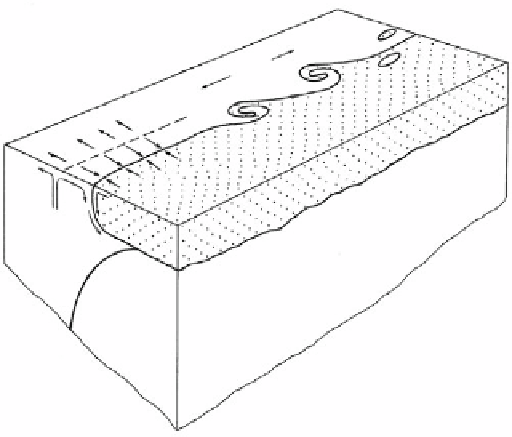Geoscience Reference
In-Depth Information
h/u
3
increase
~
2
5
k
m
Frontal Jet
Figure 8.11
Schematic illustration of the structure and residual flows associated with a tidal
mixing front. Adapted from (Simpson
1981
) with permission from the Royal Society, London.
8.6
Frontal structure and biology
......................................................................................................................
By now, you should appreciate that tidal mixing fronts, although defined in a
straightforward way as the transitions between mixed and stratified systems, are
complicated and, in some ways, rather subtle physical systems. At about the same
time that the features were being recognised in the physical structure of shelf seas, it
also became clear that the fronts were playing a role in the biochemistry (Pingree
et al.,
1975
; Fogg,
1988
). In particular, sections through fronts indicated enhanced
chlorophyll concentrations in the surface waters at fronts, as seen in the early data
from the Ushant front in
Fig. 8.12a
. Satellite observations, such as the SST and
ocean colour images in
Fig. 8.12b
,
c
, often show a surface manifestation of chloro-
phyll linked to the temperature gradient at the fronts in satellite images.
In addition to the large-scale shelf sea tidal mixing fronts, it was found that
isolated islands in stratified regions could generate localised mixing due to the
enhanced stirring brought about by the increased tidal currents in the shallowing
water on the flanks of the islands. You can see this feature around the Isles of Scilly in
the satellite images of
Fig. 8.12
(Simpson et al.,
1982
). Measurements of water
properties on a section extending southwards from the Isles of Scilly, shown in
Fig. 8.13
, illustrate how the physical structure and the chlorophyll distribution
around the islands have similar patterns to the larger scale shelf sea tidal mixing
fronts. Note in
Fig. 8.13c
how the nitrate distribution is also correlated with
the density structure of the front. Cold, sub-thermocline water contains the greatest
concentrations of nitrate, locked below the thermocline when stratification began in










Search WWH ::

Custom Search